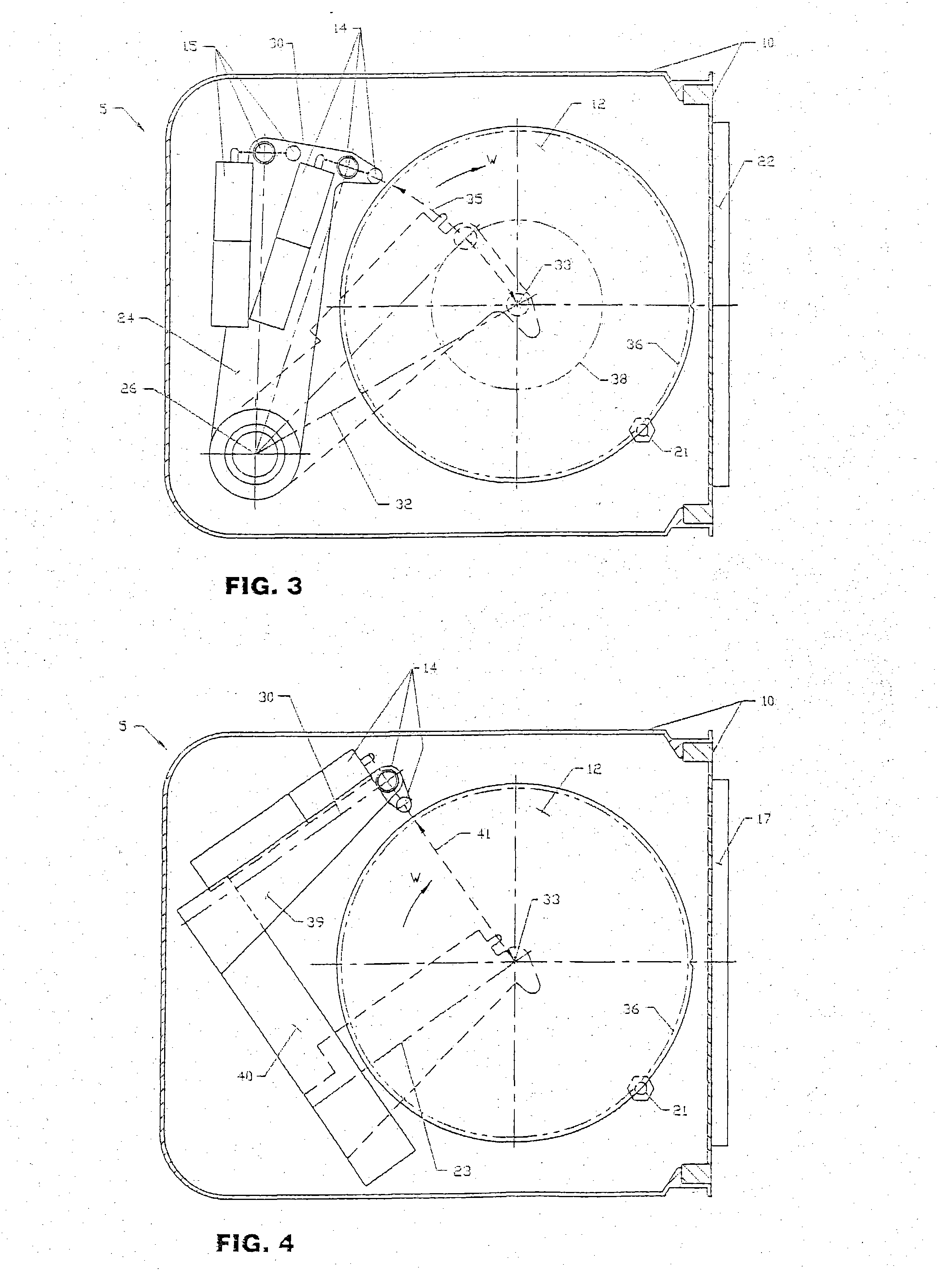Method and apparatus for locating/sizing contaminants on a polished planar surface of a dielectric or semiconductor material
a dielectric or semiconductor material, highly polished technology, applied in the direction of color/spectral properties measurement, instruments, material analysis, etc., can solve the problems of existing wafer scanning tools, time-consuming searching for sub-micron contaminants, and non-functional chips, so as to minimize the specular reflection of incident light, maximize the capture of scattered light, and the effect of high numerical apertur
- Summary
- Abstract
- Description
- Claims
- Application Information
AI Technical Summary
Benefits of technology
Problems solved by technology
Method used
Image
Examples
second embodiment
[0035]FIG. 3 illustrates scanning module 5 in which the time to scan a wafer is halved by modifying pivot arm 24 to accommodate a second instrument group 15, identical to and spaced from instrument group 14 by a distance approximately equal to half the wafer radius along arc 35. All other elements of scanning module 5 are otherwise unchanged. Instrument group 14 thus scans from a new start scan circle 38 to stop scan point 33 while instrument group 15 simultaneously scans from start scan circle 36 to a stop scan circle that is essentially the same as start scan circle 38 for instrument group 14 (in practice there is a small overlap of these start and stop scan circles). Start scan circle 38 has half the radius of start scan circle 36.
third embodiment
[0036] scanning module 5 is illustrated in FIG. 4 wherein pivoting arm 24 is replaced by a cantilever arm 39 attached to a linear stage 40 to move instrument group 14 so that its projected laser beam illuminated spot follows a linear path 41 on wafer top surface 16. All other elements of scanning module 5 are otherwise unchanged.
[0037] It follows that the dual instrument group concept of FIG. 3, used to halve the scan time, can be extrapolated to include more than two instrument groups disposed on a suitable pivot arm (ala FIG. 3) or cantilever arm (ala FIG. 4) where the scan time reduction factor is the member of instrument groups employed.
[0038] Irrespective of the scanning module 5 internal configuration the overall compact and portable system data processing electronics / computers, power supplies / distribution, vacuum source, and touch screen control / display are located outside of scanning module 5 as conceptually illustrated in FIG. 5. Therein the overall system is comprised of ...
first embodiment
[0050]FIGS. 10A and 10B in conjunction with FIGS. 1 through 4, presents top and front views (showing component relative size proportions) of instrument group 14 positioned at a constant distance just above wafer top surface 16 and configured according to scanning module 5. Instrument group 14 is comprised of a laser 62 (in the ≦470 nm preferred wavelength range), laser beam conditioning optics 64, scattered light collector 66 (a highly elongate ellipsoidal reflector), a scattered light detector 68, and the optional reflected light beam dump / CCD camera (or other detector) 70.
[0051] The laser beam conditioning optics 64 include an electronically controlled beam shutter and produce a diffraction limited beam with a circular cross-section, a symmetrical Gaussian irradiance distribution about the optical axis, and finely focused to a circular point centered on the optical axis of the beam. The focal point on the laser beam optical axis is permanently positioned to be coincidental with th...
PUM
 Login to View More
Login to View More Abstract
Description
Claims
Application Information
 Login to View More
Login to View More - R&D
- Intellectual Property
- Life Sciences
- Materials
- Tech Scout
- Unparalleled Data Quality
- Higher Quality Content
- 60% Fewer Hallucinations
Browse by: Latest US Patents, China's latest patents, Technical Efficacy Thesaurus, Application Domain, Technology Topic, Popular Technical Reports.
© 2025 PatSnap. All rights reserved.Legal|Privacy policy|Modern Slavery Act Transparency Statement|Sitemap|About US| Contact US: help@patsnap.com



